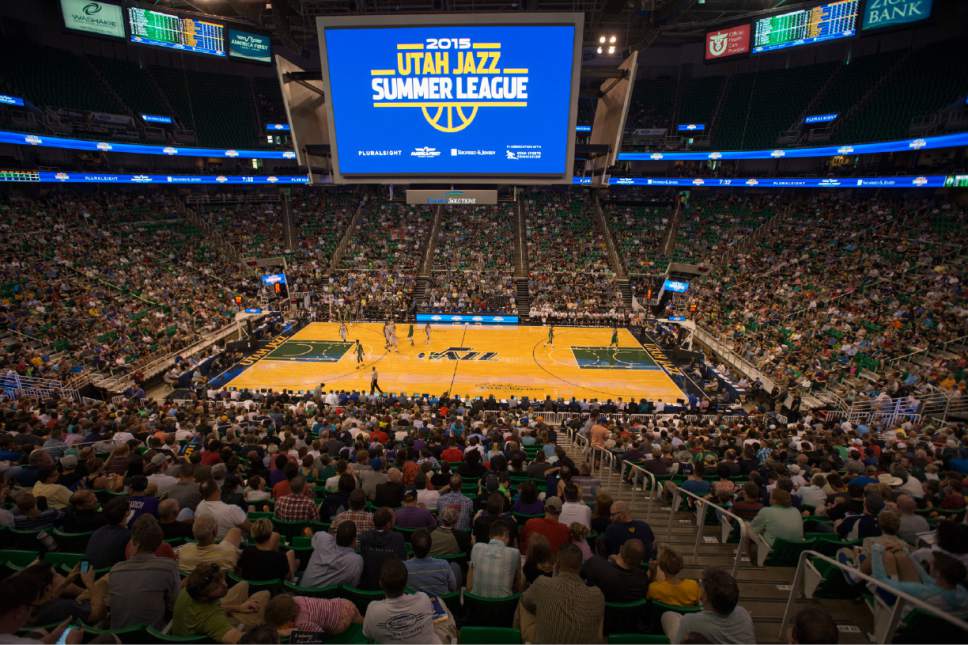This is an archived article that was published on sltrib.com in 2016, and information in the article may be outdated. It is provided only for personal research purposes and may not be reprinted.
Utah Jazz officials are ready to start checking off some arena projects on their summer to-do list.
Vivint Smart Home Arena is scheduled to undergo $110 million in renovations between now and October 2017, beginning with improvements to the building's roof and Wi-Fi system this summer. But first, Larry H. Miller Sports officials will ask Salt Lake City to approve a tax reimbursement plan that could help the company recoup more than $22 million.
The plan, which will be presented to the Salt Lake City Redevelopment Agency (RDA) on Tuesday, calls for Larry H. Miller Sports (LHM) to initially foot the entire bill for the renovation. But then LHM is asking the city to funnel 40 percent of new property taxes the company pays for the arena — up to $22.7 million — back to it over a period of 25 years.
"It's really important to us as a family that, as we move forward with this upgrade or rejuvenation to the arena, that we do it in a way that is fair and responsible," said Greg Miller, the Jazz's governor on the NBA board and son of the late Larry H. Miller.
Debuting in 1991 as the Delta Center, the arena cost $93 million to build, with about a quarter of that covered by public dollars that paid for infrastructure around the arena. This time around, Jazz officials are asking the city for a tax break that would cover about 18 percent of the cost of the renovation.
The plan would utilize an existing RDA program. If approved by the city, the proposal would mean that LHM receives reimbursement if the value of the building, and thus its property tax, increases as a result of the renovation.
"It's basically pay for performance," RDA Chairwoman Lisa Adams said. "If they perform, they get paid for it. When they do well, they get their money."
The Jazz expect the RDA to vote on the matter Tuesday.
The arena was the seventh oldest used by NBA teams last season. All of the older buildings, however, have undergone major renovations or plan to renovate or build new arenas.
Miller said arena officials studied the possibility of building a new arena, but that the design of the 25-year-old building made it possible to renovate.
"It will give us what I think will be a new arena at a very economical price," Miller said.
LHM has teamed up with Icon Venue Group, a company that recently has been involved in the restoration of Wrigley Field in Chicago, the construction of the new Golden 1 Center in Sacramento and planning for the new home of the NBA's Milwaukee Bucks. SCI Architects, which headed up the $1 billion renovation of New York's Madison Square Garden, also is part of the Jazz's renovation team.
The Millers have put about $25 million into arena renovations in recent years, including $15 million to install high-definition video screens. Another $110 million will be spent on renovations — which will include solar panels, upgraded security features and upgraded seating — over the next two years.
"Things that can be done this offseason, we're going to do that," Jazz President Steve Starks said. "But the lion's share of the work will be done next offseason, starting as soon as the Jazz's season ends, which we hope is in June, and ending sometime in October to be ready for preseason games."
Jazz officials said city leaders and downtown stakeholders have been supportive of their plan for financing the renovation of a building that attracts about 1.8 million visitors each year.
Miller called the Jazz and the arena "a community asset."
"We just happen to be the ones charged with protecting it. I don't see that changing ever, certainly not as long as my mom [LHM owner Gail Miller] or my generation has a vote in it," he said. "So in that vein, we just want to do what we can so that our fans and our guests continue to have the opportunity to enjoy Jazz games and do that in a way that's on par with other venues in the league."
Twitter: @aaronfalk



